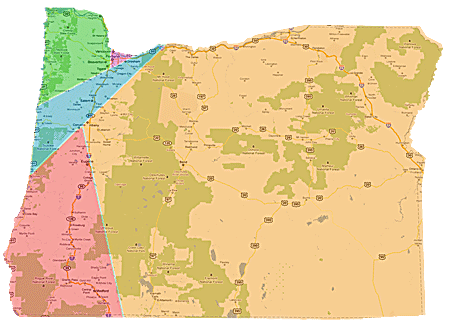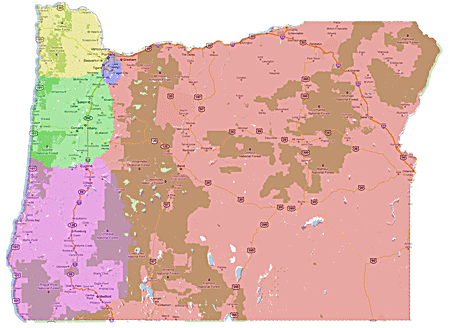Jim Huffman calls for mathematical redistricting. A very bad idea.
Kari Chisholm
Writing in the Oregonian, 2010 Senate loser Jim Huffman argues that Secretary of State Kate Brown ought to turn over redistricting to "computer nerds from some distant place such as MIT, where they have probably never heard of Oregon."
He wants them to develop a computer system "sort of like the BCS rankings in college football" and "write a program based on the existing [redistricting] criteria" and "let the chips fall where they may." He's not the first to suggest this. In fact, serious mathematicians wrestle with the idea all the time.
It's certainly a seductive idea. After all, couldn't a computer come up with a better map than all this messy democracy stuff? It's especially seductive to me - as a political hack, map nerd, and a guy who pays way too much attention to college football. Seductive enough that I've been reading up on computerized mathematical redistricting for some years now.
And let me tell you: it won't work.
Or, more accurately, it ends up being just as political and messy as anything we're doing now. After all, you have to define what a "perfect" district would look like and how the model would work.
Should you just slice the state into five perfectly vertical north-south stripes of equal population? Or maybe you should start at the population center of the state and produce five pizza-pie slices. Or maybe you could pick a corner of the state and have a computer spread the district like an amoeba, optimizing for compactness. These are all ideas that serious people have proposed as mathematical solutions to the redistricting problem.
One oft-cited method would be the shortest-splitline algorithm from Temple University's Warren Smith. Basically, draw the shortest line across Oregon that would split the state on a 3:2 ratio. Then, do that again, splitting the bigger chunk into 2:1 ratio. Then split the two remaining big chunks in half. Presto - five districts!
Unfortunately, here's what that would look like (courtesy of a programmer named Ivan Ryan.)
 (Note that this is based on the 2000 census numbers. Click to zoom.)
(Note that this is based on the 2000 census numbers. Click to zoom.)
Another map nerd and software engineer, Brian Olson, has produced a computer program to draw maps "where people have the lowest average distance to the center of their district." Here's what that would look like for Oregon (with 2010 census numbers):
A little prettier, but still splitting up cities and counties all over the place. And note, Professor Huffman, that both of these mathematically-modeled maps split the Portland metro area in ways that tend to make your GOP friends scream.
Writing in Slate in 2009, Chris Wilson summed it up:
In theory, it makes wonderful sense to hire an algorithm to do the job. Simply plug in all the requirements for a congressional district—relatively equal population, compliance with the Voting Rights Act, and so forth—and let the nonpartisan processor divvy up the state into sensible, shapely chunks. Algorithms, after all—thanks in part to Google—are having a great decade. ...
So, why is an algorithmic solution for congressional redistricting such a pipe dream?
In part it's because it is surprisingly hard to define, or at least reduce to a set of rules, what a "gerrymandered district" is. Writing a formula for drawing districts requires us to define how funny-looking is too funny looking. And what is funny, anyway?
In short, it's a pretty bad idea. While you get some mathematical neutrality, you end up jettisoning all the human aspects - what makes community, which roads divide communities and which ones connect them, (usually) political boundaries like cities and counties and school districts, and never mind a key legal requirement that Huffman failed to quote in his op-ed: that "no district shall be drawn for the purpose of diluting the voting strength of any language or ethnic minority group." All that, and legislators still have to be the ones that decide which mathematical algorithm gets used and what criteria it should utilize and prioritize.
Of course, this bad idea is coming from a guy who ran against Ron Wyden and spent $2,177,539 more than Al King did in 2004 against Wyden - but only moved the needle from 32% to 39%. That's over $300k per percentage point.
Bad ideas seem to be his thing.
 |
More Recent Posts | |
Albert Kaufman |
|
Guest Column |
|
Kari Chisholm |
|
Kari Chisholm |
Final pre-census estimate: Oregon's getting a sixth congressional seat |
Albert Kaufman |
Polluted by Money - How corporate cash corrupted one of the greenest states in America |
Guest Column |
|
Albert Kaufman |
Our Democrat Representatives in Action - What's on your wish list? |
Kari Chisholm |
|
Guest Column |
|
Kari Chisholm |
|
connect with blueoregon





2:20 p.m.
May 17, '11
I like the Brian Olson, least distance traveled, alternative. I'm OK with splitting cities and counties. What else is wrong with it?
4:58 p.m.
May 17, '11
Jim Huffman is a landslide loser. Why does his opinion count and why are you wasting space on it here, Kari, especially since it is a non-starter?
10:21 p.m.
May 17, '11
Because apparently the Oregonian thought it was worthy of newsprint.
The idea is seductive. I thought it worthwhile to actually discuss whether it was a good idea.
5:32 p.m.
May 17, '11
Kari,
Love the analysis. For some reason, people who do not work with programming or computers tend to have more faith in computers solving problems than those of us who have implemented systems. Huffman forgot the basic starting point of all computer programs; garbage in, garbage out.
As you point out the issue is the parameters you choose. Over time we might get it right, but it will take time and unfortunately we are stuck with a solution for ten years. Wouldn't want to do it untouched by human hands. Any one remember Hal? Dave, Dave, why are you doing that? Dave?
8:11 p.m.
May 17, '11
There's something I haven't seen in discussions of redistricting on either side of the political spectrum: Restraint.
Why not choose the redistricting plan that causes the fewest people to change districts? The whole process is at best a necessary evil, the less of it the better.
8:54 p.m.
May 17, '11
I was restricted to 3000 characters, so I made a quick blog entry in response. It could probably use some editing and further work, but I'm not a full time politico and just want to get the essence out there. In summary, Kari's got it all wrong and her bias is showing. My view is from a spatial database expert, software engineer, and election reform advocate that has been advocating for real election reform rather than this status quo nonsense.
http://swoolley.org/blog.cgi/response%20to%20blueoregon%20kari%20chisholm%20on%20automated%20redistricting
10:26 p.m.
May 17, '11
Welcome to BlueOregon.
I'm a "he", not a "her".
1:36 a.m.
May 18, '11
Sorry, my fingers type with muscle memory, I knew you are a he and didn't re-read it closely.
10:30 p.m.
May 17, '11
Just read your post. Interesting stuff.
I agree that proportional representation or ranked choice voting would be an improvement.
As to whether you could, in fact, develop a computerized districting model that is somehow magically neutral (perhaps by, as you say, scientifically sampling everyone in Oregon as to which communities of interest they feel part of -- how big would that sample be?).... well, I think that's a pipe dream.
We have a method for scientifically sampling the electorate and combining that with human judgment -- they're called elections.
As messy as democracy is sometimes, and redistricting is very messy, it's still the best system there is for handling complex, highly-charged, multi-variable analysis and decision-making. Not perfect, but as good as it gets.
2:02 a.m.
May 18, '11
It isn't magically neutral. If you setup the process that has as many parameters setup in advance you can use more scientific approaches to the true questions -- the criteria in the statutes. Those are political criteria as far as how they are weighted but can be discerned with facts as input. Even establishing a computer system itself is political -- as is your point, but there is no reason for it not to be politically fair (which is my point).
I view the method of drawing boundaries as a critical part of democracy, and it can't be left to something that isn't democratic (our current redistricting process) or it has no ontological foundation. Having a system where there are infinite opportunities to corrupt it by the majority party (or the SoS) is oligarchy (or monarchy) -- making a mockery of the supposed democracy of election by districts.
I can get behind your desire to use elections to determine the communities of interest -- cumulative voting as I described would be wonderfully accurate if we polled everybody, but for our purposes a scientific sample is probably good enough to make the districts 99.9% the same as a full poll. It's better than the current system of a few public hearings where the communities of interest are just supposed to show up and lobby their way into the swipe of a back-room pen (or flick of the mouse in today's modern world). And if they want as much political clout as possible, even after computer redistricting they have to move together to a possibly insular community and get drawn into a single district. The current system is a complete failure of proportionality -- redistricting can't possibly satisfy all the political goals it wants to achieve alone and saying it's terribly important to empower these communities of interest with ad-hoc public hearings when there are so many better ways makes me cringe. An algorithm seriously could do that part better even in the current system, but it could do so much better with more complete reform that doesn't require hacking districts to create proportionality.
Political hacks are just like doctors who say they can read radiological charts better than a computer, when computer-aided diagnostics are proven to dramatically save lives. The trick to how that work is the computers aid the process while the doctors make the final determinations. We can use computers to help us, but only if we don't fear them.
8:45 a.m.
May 19, '11
Numbers don't vote.
People do.
District maps will and should be designed with that in mind.
8:59 a.m.
May 19, '11
The individual using the nom de guerre of "Isaac Laquedem" has posted his thoughts on the shortest-splitline concept.
I encourage you to read it -- all the way through to the punchline.